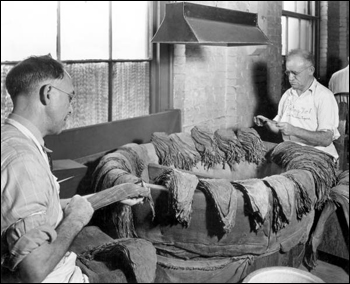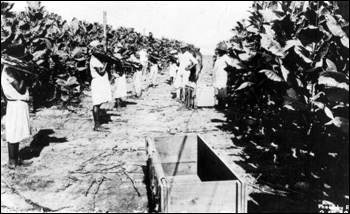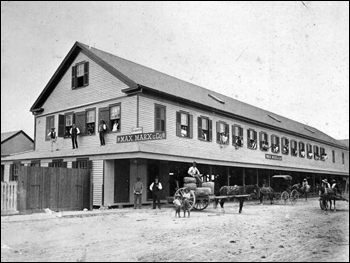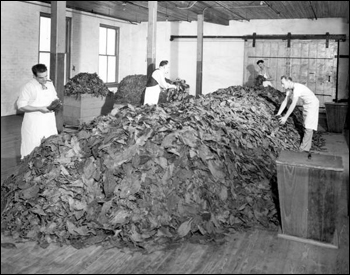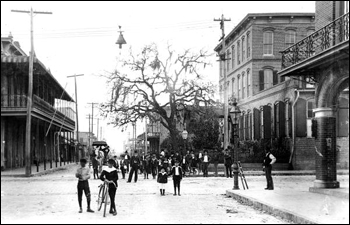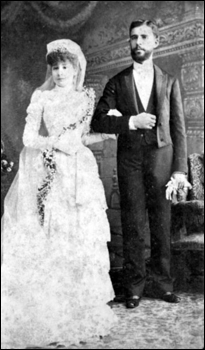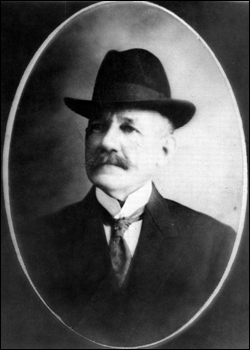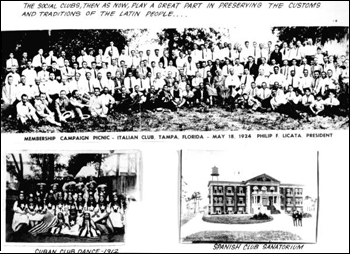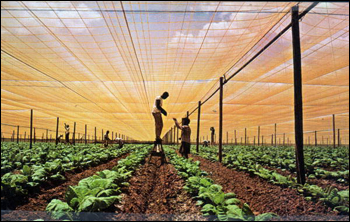Photo Exhibits
Photo exhibits spotlight various topics in Florida history, and are accompanied by brief text intended to place selected materials in historical context.
Florida Cigars
Artistry, Labor, and Politics in Florida's Oldest Industry
Workers selecting cigar wrappers: Tampa, Florida (19--)
Image Number: RC07647
Workers harvesting cigar wrapper tobacco: Quincy, Florida (19--)
Image Number: RC05260
The bottom leaves were removed from plants during "priming" and placed in barges to be taken to the curing barn for stringing and drying.
Max Marx and Company (189-?)
Image Number: N032219
"Clear Cuban"
German immigrant and New York cigar manufacturer Samuel Seidenberg established the first "clear Cuban" cigar factory in Key West in 1867. By using Cuban laborers to roll Cuban tobacco, Seidenberg pioneered the idea of making authentic Cuban cigars in America while avoiding the high tariffs levied against products from Havana, as well as the trade restrictions imposed by Spain.
The "Lector" was a fellow factory worker usually selected by the workers themselves who read aloud during work hours to help pass the time in the factory.
Vicente Martinez Ybor, one of the most significant figures in the history of cigar making in Florida, first established a cigar factory in Key West in 1869. Ybor fled Cuba, leaving behind his very successful cigar manufacturing enterprises there, after colonial authorities discovered his connections with revolutionaries.
Interior view of a cigar factory during a blending operation: Tampa, Florida (19--)
Image Number: RC17388
People stand on the intersection of 14th Street and 9th Avenue in Ybor City: Tampa, Florida (19--)
Image Number: RC09169
Havana-American Company, cigar factory.
Unions and Cuban Nationalism
Many of the workers who immigrated to Key West had already been on the vanguard of the militant trade unionism movement in Cuba, vigorously supporting the organization of skilled workers and using tactics such as general strikes to achieve collective demands.
After the failed Cuban revolution of 1868, the Cuban nationalist movement continued to grow in Key West, as well as the strength of unions. Cuban immigrants throughout Florida strongly supported the Cuban independence movement, but after the hopes of Cuban independence began to dim in the 1870s, many workers turned towards trade unionism with even more vigor.
Within a decade, strikes and organized resistance to factory demands were common place. Over the next two decades, cigar workers became increasingly organized and strikes more frequent, helping to push more of the Cigar manufacturers to leave Key West, mostly resettling in the Tampa Bay area.
Jenny and Ygnacio Castaneda on their wedding day (1890)
Image Number: N045400
Jenny was the daughter of Vicente Martinez Ybor. Vicente, with the help of personal underwriting by the members of the Tampa Board of Trade, bought 40 acres for $4,000 in 1885, built the first cigar factory in the area and moved his cigar making operation from Key West to Tampa. He brought workers from Cuba to work in his factory and built and rented houses to them. The area grew and became known as Ybor City.
Emilio Pons, Sr.
Image Number: N043605
Established the Emilio Pons Cigar Factory with Candido Ybor in 1889.
Tampa's "Latin Quarters"
Ybor bought the land near the City of Tampa that would come to bear his name in 1885 anticipating the need to open new factories and for the growing Florida cigar industry to expand while minimizing the effects of labor militancy. Prolonged and violent strikes in 1889 and the early 1890s, in addition to a devastating fire of 1886, spurred even more factories to relocate. Soon after its founding, Ybor City emerged as a vibrant and rapidly growing Spanish-speaking community.
In order to maintain political control over the new population, the City of Tampa annexed Ybor City in 1887. The community of West Tampa was found in 1892 by the Scottish land developer Hugh C. Macfarlane to be a competing cigar center in the area. Macfarlane and other developers gave land and buildings to cigar factories in order to promote settlement and unlike Ybor City, that community remained independent until 1925.
A strong relationship soon developed between the workers in the West Tampa and Ybor City, with easy transportation between the two Latin quarters allowing frequent commuting for social activities, visiting family members, and finding competing sources of employment.
Three views of ethnic social clubs from the area: Tampa, Florida (19--)
Image Number: N043529
Note from top of picture: "The social clubs, then as now, play a great part in preserving the customs and traditions of the Latin people...."
Note from caption accompanying top image: "Membership campaign picnic - Italian Club, Tampa, Florida - May 18, 1924 Philip F. Licata, President."
Note under bottom left image: "Cuban Club Dance - 1912."
Note under bottom right image: "Spanish Club Sanatorium."
Workers tie up tobacco: Quincy, Florida (1965)
Image Number: PC5858
Shade-grown tobacco is grown for cigar wrappers. "Tying Up," shown here, provides a cord support for such a rapidly growing, big-leafed plant as it grows to the top of the shade. Gadsden County, Florida, is the major producing area--and one of the only two shade producing areas--in the United States.
Florida Tobacco
Cigar factories appeared in numerous Florida cities besides Key West and Tampa during the late 19th century, such as in Jacksonville and the Wanish Factory in Tallahassee. Tobacco remained an important agricultural product in north Florida, particularly in Gadsden County, where tobacco was a chief agricultural product for more than 150 years.
Quincy in Gadsden County was the American center for "shade tobacco" production until the 1970s, and factories produced cigars and cigarettes in Quincy and Havana, Florida, named after the Cuban capital.

 Listen: The Folk Program
Listen: The Folk Program